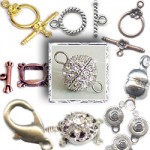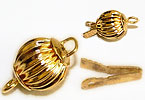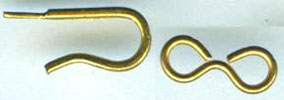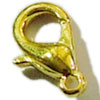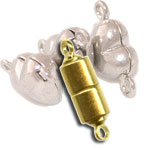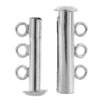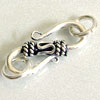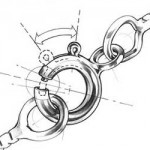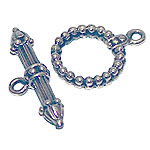Pictures, descriptions, and explanations on some of the most popular, common, and basic types of jewelry clasps.
Jewelry Clasps are one of the jewelry findings that are most common and most essential. Bracelet clasps and necklace clasps are the most popular functional jewelry fasteners around.
Functionally, clasps are merely fasteners that are used to connect and end off bracelets, anklets, and necklaces. However clasps do not just have to be only functional. They can be an integral part of the design; sometimes the focal point of interest.
These days, there are more and more decorative jewelry clasps available for purchase. Clasps can come in many designs, many different finishes, and made from various grades of materials. For top end jewelry, sterling silver, gold, platinum, rhodium are common materials used to manufacture these jewelry fasteners.
As specialist companies continue to produce new clasps designs, it is impossible to produce a comprehensive list of jewelry clasps. However it is still useful to know some of the basic and long-enduring types of clasps available.
Types of Basic Jewelry Clasps with Descriptions
Box Clasp – The box clasp consists of 2 parts. One part has a box or housing which has a notched/grooved opening.
The other part of the box clasp is a folded, springy flat piece of metal: the tongue. The tongue acts like a spring or lever. The tongue is designed to slip into the groove of the other part of the box clasp, with a bit left hanging out. It is the springy compression of the tongue that, when in the groove, holds the box clasp closed.
Tip: If the box clasp becomes ineffectual, a handy remedy could be just as easy as pulling the flaps of the “tongue” apart so that it provides stronger tension when slotted into the groove at the other end.
Hook and Eye Clasp – The hook and eye fastener has been around for a very long time. It is a simple yet effective fastener. You can easily make a hook and eye clasp yourself with an appropriately thick gauged wire.
The hook and eye fastener is made with a simple hook on one side and an eye on the other end.
The picture here depicts the eye-end shaped like a figure “8”. However it can be any shape as long as the hook end can link into it and thereby, allow the jewelry piece to be fastened.
These types of jewelry clasps are used in single as well as multi-strand jewelry pieces. It is better to just the hook & eye clasps for heavier types of jewelry. The weight on each side of the clasp ensures the fastener remains closed during wear.
Lobster Clasp / Parrot Clasp – I normally refer to this as a Lobster clasp. After all, it does look like the claw of a lobster. However I notice that in American literature especially, this is often referred to as a Parrot Clasp. I will be using both terms interchangeably to mean the same thing.
The lobster clasp is one of the easiest and most popular jewelry clasps around. For beginners, this is definitely a very handy kind of fastener to use. They are especially secure for heavy-ish jewelry.
Parrot clasp employs tension from a spring-loaded mechanism that keeps the clasp securely closed. A little trigger handle on the clasp allows the wearer to open the “claw”. This can then be used to catch a jump-ring, ring or loop at the other end of the jewelry piece.
Nowadays, the lobster clasp can be seen in a huge variety of shapes, decorative designs, and sizes. As with all jewelry clasps, they can be obtained in different materials, colors, platings.
Magnetic Clasp – Magnetic clasps are of a more modern invention. It continues to grow in popularity as it is so easy to use. The shapes, sizes, color, and designs of these types of clasps have also grown exponentially in recent times.
Magnetic claps are very easy to put on and take off. There is less fiddling with tiny parts which can be quite cumbersome at times. They are often a god-send for people with arthritis and/or for the elderly.
Caution Magnetic clasps should not be used for:
- pregnant women
- people with pacemakers
- very heavy jewelry
The clasps should also be kept away from any equipment that may be affected by magnetic fields (e.g. VDUs or display monitors). And unless the magnet in the clasps are strong enough, they are not suitable for heavier pieces of jewelry.
Slide Lock Clasp or Tube Bar Clasp – I love these clasps! They are ideal for flat, wide bracelets.
This jewelry clasp gets its name from its specific closing mechanism. One side of the clasp is an open hollow tube with a open-groove in it. The other side of the clasp is slotted into the tube and groove.
Modern versions of the Slide clasp may also include a magnetic feature – making it easier to use than ever before.
S Hook or S Clasp – There was a time before jewelry clasps were as prolific, impressive, and easily accessible as they are now. Back in those days, the S Hook used to be used much more frequently than it is today.
The S Clasp can range from very simplistic to very ornate designs.
You can easily make your own S Clasp with just some pliers and thick, strong wire. They remain very popular these days because they remain one of the easiest of fasteners for the wearer.
Spring Ring Clasp – Spring ring clasp employs a spring mechanism within a circular tubing that forms the main part of the clasp. When opened, the clasp can hook onto a loop or jump-ring at the other end of the jewelry piece.
The clasp is opened by pulling back the arm and the spring-mechanism automatically closes the clasp when the arm is released.
Traditionally this spring ring clasp was only offered as a round shape. These days it can be found in a variety of fancy shapes, colors, and surface designs.
Toggle Clasp – Toggles have always been one of the very popular forms of jewelry clasps. It is now even more popular than ever before as beautiful new shapes and designs are being produced every day.
Toggles are very easy to use. Many artists even create their own beaded toggles which are quite amazing to behold.
Toggles work exceptionally well for necklaces.
A few precautions should be taken when shopping for toggle clasps: always ensure that the length of the T-bar will fit securely into the other end (the “hole”). And that the overlap is sufficient so that the T-bar will not slip out during wear. This is especially important for tiny toggle clasps.
This is just a short listing of some of the most common jewelry clasps around. What are your favourite clasps? Are there any types of clasps you would never use?
